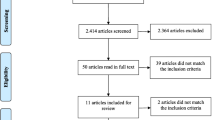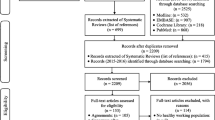Abstract
Increasing levels of physical activity are proven to have a positive impact on physical health and mental well-being. Physical activity is also known to influence work-related outcomes such as reducing sickness absence. Sickness absence is a major public health problem with wide economic impact on society and there may be much to gain from physical activity interventions aimed at preventing long-term sickness absence. Examining the relationship between physical activity and sickness absence is therefore important as it may provide benefits to organisations globally. This article provides a review of the evidence on the relationship between physical activity and sickness absence among employees. A search of databases (Web of Science, ScienceDirect, MEDLINE and Google Scholar) and references of published studies (from inception to 14 November 2012) were conducted to identify intervention studies and observational studies involving employees. A total of 37 studies published between 1981 and 2012 met the inclusion criteria. Evidence from the review suggests that physical activity is effective in reducing sickness absence. However, the studies highlighted a number of methodological concerns, including lack of description of the physical activity programme in intervention studies and use of self-report physical activity in observational studies. We conclude that, overall, the available evidence provides limited support that physical activity is effective in reducing sickness absence, due to the low quality of many of these studies. Future research should provide more detailed descriptions of the physical activity programme and use more reliable objective measures of physical activity such as accelerometers and fitness tests.

Similar content being viewed by others
References
Health Survey for England. Cardiovascular disease and risk factors: summary of key findings. NHS; 2006. http://www.hscic.gov.uk/pubs/hse06cvdandriskfactors. Accessed Nov 2012.
Troiano RP, Berrigan D, Dodd KW, et al. Physical activity in the United States measured by accelerometer. Med Sci Sports Exerc. 2008;40(1):181–8.
World Health Organization. Global recommendations on physical activity for health. Geneva: WHO Press; 2010.
Robroek SJ, van den Berg TI, Plat JF, et al. The role of obesity and lifestyle behaviours in a productive workforce. Occup Environ Med. 2011;68(2):134–9.
van Amelsvoort LG, Spigt MG, Swaen GM, et al. Leisure time physical activity and sickness absenteeism: a prospective study. Occup Med. 2006;56(3):210–2.
Kerr JH, Vos MCH. Employee fitness programmes, absenteeism and general well-being. Work Stress. 1993;7:179–90.
Laaksonen M, Piha K, Martikainen P, Rahkonen O, et al. Health-related behaviours and sickness absence from work. J Occup Environ Med. 2009;66:840–7.
Proper KI, van den Heuvel SG, de Vroome EM, et al. Dose-response relation between physical activity and sick leave. Br J Sports Med. 2006;40:173–8.
Kivimäki M, Forma P, Wikström J, et al. Sickness absence as a risk marker of future disability pension: the 10-town study. J Epidemiol Community Health. 2004;58:710–1.
Vahtera J, Westerlund H, Ferrie J, et al. All cause and diagnosis-specific sickness absence as a predictor of mortality: the Whitehall II prospective cohort study. BMJ. 2008;337:a1469.
Confederation of British Industry. Healthy returns? Absence and workplace health survey. London: CBI Publications; 2011. p. 1–36.
Nurminen E, Malmivaara A, Ilmarinen J, et al. Effectiveness of a worksite exercise program with respect to perceived work ability and sick leave among women with physical work. Scand J Work Environ Health. 2002;28(2):85–93.
Pronk NP, Martinson B, Kessler RC, et al. The association between work performance and physical activity, cardiorespiratory fitness, and obesity. J Occup Environ Med. 2004;46(1):19–25.
Higgins JPT, Green S. Cochrane handbook for systematic reviews of interventions. Version 5.1.0 (updated March 2011). The Cochrane Collaboration. http://www.cochrane-handbook.org.
Brox J, Frøystein O. Health-related quality of life and sickness absence in community nursing home employees: randomised controlled trial of physical exercise. Occup Med. 2005;55:558–63.
Halfon ST, Rosenfeld O, Ruskin H, et al. Daily physical activity program for industrial employees. In: Kaneko M, editor. Fitness for the aged, disabled, and industrial worker. Champaign: Human Kinetics; 1994. p. 260–5.
Rosenfeld O, Tenenbaum G, Ruskin H, et al. The effect of physical training on objective and subjective measures of productivity and efficiency in industry. Ergonomics. 1989;32:1019–28.
Rosenfeld O, Tenenbaum G, Ruskin H, et al. Behavioural modifications following a physical activity programme in the Israeli pharmaceutical industry. Aust J Sci Med Sport. 1990;22(4):93–6.
Reijonsaari K, Vehtari A, Kahilakoski O-P, et al. The effectiveness of physical activity monitoring and distance counseling in an occupational setting: results from a randomized controlled trial (CoAct). BMC Public Health. 2012;12:344.
Van Rhenen W, Blonk RWB, Schaufeli WB, et al. Can sickness absence be reduced by stress reduction programs: on the effectiveness of two approaches. Int Arch Occup Environ Health. 2007;80:505–15.
Zavanela PM, Crewther BT, Lodo L, et al. Health and fitness benefits of a resistance training intervention performed in the workplace. J Strength Cond Res. 2012;26(3):811–7.
Blair S, Smith M, Collingwood T, et al. Health promotion for educators: impact on absenteeism. Prev Med. 1986;15:166–75.
Cox M, Shephard R, Corey P. Influence of an employee fitness programme upon fitness, productivity and absenteeism. Ergonomics. 1981;24(10):795–806.
Song T, Shephard R, Cox M. Absenteeism, employee turnover and sustained exercise participation. J Sports Med. 1982;22:392–9.
Shephard R. Twelve years’ experience of a fitness program for the salaried employees of a Toronto Life Assurance Company. Am J Health Promot. 1992;6(4):292–301.
Altchilder L, Motta R. Effects of aerobic and non-aerobic exercise on anxiety, absenteeism, and job satisfaction. J Clin Psychol. 1994;50(6):829–40.
Baun W, Bernacki E, Tsai S. A preliminary investigation: effect of a corporate fitness program on absenteeism and health care cost. J Occup Med. 1986;28(1):18–22.
Eriksen HR, Ihlebaek C, Mikkelsen A, et al. Improving subjective health at the worksite: a randomized controlled trial of stress management training, physical exercise and an integrated health programme. Occup Med. 2002;52(7):383–91.
Lechner L, de Vries H, Adriaansen S, et al. Effects of an employee fitness program on reduced absenteeism. J Occup Environ Med. 1997;39(9):827–31.
Bergstrom G, Björklund C, Fried I, et al. A comprehensive workplace intervention and its outcome with regard to lifestyle, health and sick leave. Work. 2008;31:167–80.
Christensen KB, Lund T, Labriola M, et al. The impact of health behaviour on long term sickness absence: results from the DWECS/DREAM. Ind Health. 2007;45:348–51.
Eriksen W, Bruusgaard D. Physical leisure-time activities and long-term sick leave: a 15-month prospective study of nurses’ aides. J Occup Environ Med. 2002;44:530–8.
Holtermann A, Hansen JV, Burr H, et al. The health paradox of occupational and leisure time physical activity. Br J Sports Med. 2012;46:291–5.
Lahti J, Laaksonen M, Lahelma E, Rahkonen O. The impact of physical activity on sickness absence. Scand J Med Sci Sports. 2010;20:191–9.
Lahti J, Lahelma E, Rahkonen O. Changes in leisure-time physical activity and subsequent sickness absence: a prospective cohort study among middle-aged employees. Prev Med. 2012;55(6):618–22.
Strijk JE, Proper KI, Stralen MM, et al. The role of work ability in the relationship between aerobic capacity and sick leave: a mediation analysis. Occup Environ Med. 2011;68:753–8.
van den Heuvel SG, Boshuizen HC, Hildebrandt VH, et al. Effect of sporting activity on absenteeism in a working population. Br J Sports Med. 2005;39(3):e15. doi:10.1136/bjsm.2004.013052.
Burton WN, McCalister KT, Chen CY, et al. The association of health status, worksite fitness center participation, and two measures of productivity. J Occup Environ Med. 2005;47(4):343–51.
Daley AJ, Parfitt G. Good health—is it worth it? Mood states, physical well-being, job satisfaction and absenteeism in members and non-members of a British corporate health and fitness club. J Occup Organ Psychol. 1996;69:121–34.
Hendriksen IJ, Simons M, Garre FG, et al. The association between commuter cycling and sickness absence. Prev Med. 2010;51(2):132–5.
Jacobson B, Aldana S. Relationship between frequency of aerobic activity and illness-related absenteeism in a large employee sample. J Occup Environ Med. 2001;43(12):1019–25.
Kyrōläinen H, Häkkinen K, Kautiainen H, et al. Physical fitness, BMI and sickness absence in male military personnel. Occup Med. 2008;58:251–6.
Steinhardt M, Greenhow L, Stewart J. The relationship of physical activity and cardiovascular fitness to absenteeism and medical care claims among law enforcement officers. Am J Health Promot. 1991;5(6):455–60.
Wattles MG, Harris C. The relationship between fitness levels and employee’s perceived productivity, job satisfaction, and absenteeism. JEP Online. 2003;6(1):24–32.
Proper KI, Staal BJ, Hildebrandt V, et al. Effectiveness of physical activity programs at worksites with respect to work-related outcomes. Scand J Work Environ Health. 2002;28:75–84.
Ogdeen M, Magnussen LH, Maeland S, et al. Systematic review of active workplace interventions to reduce sickness absence. Occup Med. 2013;63:7–16.
Acknowledgments
No funding provider was involved in the production of this paper. None of the authors have any conflicts of interest. All individuals who made substantial contributions to this work met the criteria for authorship. We would like to thank Professor Eef Hogervorst for her expertise and guidance with this work.
Author information
Authors and Affiliations
Corresponding author
Rights and permissions
About this article
Cite this article
Amlani, N.M., Munir, F. Does Physical Activity Have an Impact on Sickness Absence? A Review. Sports Med 44, 887–907 (2014). https://doi.org/10.1007/s40279-014-0171-0
Published:
Issue Date:
DOI: https://doi.org/10.1007/s40279-014-0171-0




